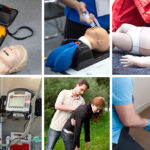When it comes to cardiopulmonary resuscitation or CPR, there are many things to consider. It’s important to think about the age of the victim, the safety of your surrounding areas, and also whether or not they are experiencing something other than cardiac failure. However, one of the most common mistakes that people make when performing CPR is not first determining whether the victim is choking. This is extremely important to proper CPR and must be quickly and efficiently determined before lifesaving procedures can begin.
American CPR Care Association is dedicated to ensuring that you have the skills necessary to save a life in the event of an emergency. We offer CPR/AED certification courses that will help you to cultivate the skills you need in order to ensure that you’re performing CPR safely and correctly.
Unfortunately, cardiac arrest is extremely common. In fact, according to the CDC, approximately 357,000 people experienced cardiac arrest outside of the hospital each year. Because a cardiac arrest is one of the leading causes of death in the United States, it’s extremely important to make sure that your CPR skills are up-to-date, and you are prepared to deal with someone experiencing heart failure.
In this blog, we will discuss what to do when administering CPR assistance to someone who is choking and let you know what to look for when beginning to perform CPR. Choking victims require special care before administering CPR, so it’s imperative that you look for such a situation before going into your normal CPR procedures. Continue reading in order to understand the signs of choking and the special measures you must take with a choking victim in order to ensure that your CPR is as effective as possible.
Noticing Signs of Choking
The first step to performing CPR on someone who has a blocked airway is to make sure that they are indeed choking. Thus, it’s important to ensure that you can determine when someone is choking so that you can react appropriately. To determine if someone is choking, look for the following signs:
- Coughing:
A choking victim will by default be trying to remove the object from their throat which is causing them to choke. This will usually result in coughing. It may be a weak cough, more like a wheeze, if the victim doesn’t have much air left. However, it may be a stronger cough if the victim is still receiving enough air to try to powerfully expel the foreign object from their throat.
- Change in Complexion:
In addition, as a choking victim loses oxygen, the color of their skin will most likely change. Watch out for a bluish tone, especially in the face and on the victim’s fingers and nails. In addition, the victim may simply appear flushed or red in the face when choking.
- Inability to Speak:
Additionally, a choking victim will typically be unable to speak and may be gesturing to their throat to indicate this fact. You can check to see if a victim is choking by simply asking them if they are choking and then seeing if they cannot respond.
- Gestures:
Finally, as previously mentioned, a victim who cannot breathe is often likely to gesture to face or neck or wrap their hands around their throat in order to indicate that they are choking. They may also fall to their knees or even lose consciousness, making it very obvious that they are losing oxygen.
How to Respond to a Conscious Choking Victim:
In addition, it’s very important to adjust your procedures depending on whether the victim you’re treating is conscious or not. If you notice that the victim has fallen unconscious while choking, it’s imperative that you follow these steps in your care:
- First, confirm that the victim is indeed choking by asking them if they are or if need help. If they do not respond or gesture in a way that confirms they cannot breathe, move on to the next step.
- Once you’ve confirmed that the victim is unable to speak or cough, it’s imperative that you begin the Heimlich Maneuver. To perform the Heimlich Maneuver, follow these steps:
- Begin by telling a specific person nearby to call 911. If no one is nearby, begin with the following steps and then call yourself.
- Position yourself behind the victim and wrap your arms around their abdomen near the belly button.
- Next, make a fist with one hand and press it firmly against the victim’s abdomen.
- Then, wrap your other hand around your first in order to ensure that you have enough strength and leverage to perform the Heimlich effectively.
- Next, pull your fists inward with an upward angle. Be sure to use strong force and continue performing the Heimlich until the victim expels the foreign object from their throat. If you haven’t already, call 911 to arrange for follow-up care from first responders.
- Finally, it’s important to remember that if the victim begins to breathe, cough or speak, it’s time to stop using the Heimlich and check on the well-being of the victim. Additionally, be sure to watch to see if the victim loses consciousness. If that is the case, then make sure you are following our recommendations for dealing with an unconscious choking victim.
How to Respond to an Unconscious Choking Victim:
An unconscious choking victim must be dealt with in an entirely different manner than a conscious one. If you notice that the victim is choking but has also fallen unconscious, follow these life-saving steps:
- First, be sure to designate someone to call 911. Call out to a specific person in the area and tell them to call 911 which you begin life-saving procedures. If there is no one in the area, begin procedures and then call 911 yourself. They will stay on the line with you and offer assistance while you’re waiting for help to arrive.
- Make sure that the victim is positioned laying on their back on the floor. Be careful in moving an unconscious victim so as to not cause damage to their head or neck.
- Next, you must try to remove the foreign object from the victim’s throat. Take one of your hands and tilt the victim’s chin back. With the same hand, use your thumb to press the victim’s tongue down into their mouth so that they cannot bite or choke on it.
- Next, take your index finger from your other hand and reach into the victim’s airway to try to hook the foreign object and remove it…
- Once the foreign object has been moved, begin normal CPR procedures consisting of 30 chest compressions and 2 rescue breaths. Make sure to keep the victim’s airway open by tilting their chin back and continue checking for breathing by placing your face near the victim’s mouth and looking to see if their chest is rising. In addition, make sure that you look to see if the victim’s chest is rising each time you offer rescue breaths. If it is not, then the victim is not receiving your oxygen, and there may still be a blockage that you need to clear.
- If the victim regains consciousness and begins breathing, discontinue CPR procedures and wait with the victim until help arrives.
Conclusion
It’s always extremely important to notice the signs of choking before administering CPR procedures. If you begin CPR on a choking victim before removing the blockage, they will not be able to receive the oxygen you are offering in your rescue breaths, and your attempts to revive them will be futile. Because it can sometimes be difficult to determine whether or not a victim is choking, it’s always recommended that you take a credible CPR certification class such as the one offered by the American CPR Care Association.
We will offer you the skills necessary to determine whether or not a victim is choking and help you know what to do in the event of a choking victim. Our courses are offered completely online and can be completed in as little as 1 hour. Reach out to us today at [email protected] or 1-888-808-9109, or chat with us online on our website. We are passionate about helping people be prepared in the event of an emergency, so contact us today in order to ensure that you know what to do when the unexpected happens.







